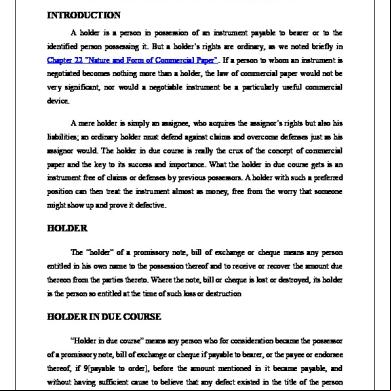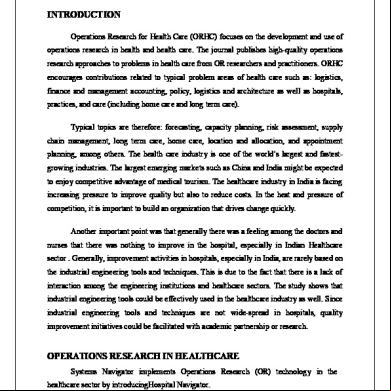E Commerce And Value Added Networks 3e3o5u
This document was ed by and they confirmed that they have the permission to share it. If you are author or own the copyright of this book, please report to us by using this report form. Report 2z6p3t
Overview 5o1f4z
& View E Commerce And Value Added Networks as PDF for free.
More details 6z3438
- Words: 1,319
- Pages: 5
E - COMMERCE - VALUE ADDED NETWORKS
INTRODUCTION Electronic Data Interchange (EDI) Value-Added Networks, more commonly known as VANs, date back to the 1980s and those now almost unimaginable years before the Internet. Originally consisting of secure phone lines used to transfer important or confidential data, VANs have since evolved to incorporate Internet functionality, but continue to provide similar services, including data transfer, storage, encryption and format conversion. Depending on the nature of your e-commerce business, a VAN may be a good choice for you.
Advantages: Safety and Reliability As a system specifically designed for secure data transfer, the information architecture behind most VANs, including everything from encryption methods to safe data transfer protocols, tends to be far more sophisticated than your average firewall or network security set-up. Naturally, such a level of security is probably unnecessary for most data, but may be a critical advantage for an e-commerce business that handles confidential data like credit card information, bank details or proprietary design information for manufacturers. VANs also tend to be more reliable than secure e-mail servers or other systems that experience periodic outages.
1
DEFINITION of 'Value-Added Network (VAN)' A private network provider hired by a company to facilitate electronic data interchange (EDI) and/or provide other network services such as message encryption, secure email and management reporting. A Value-Added Network (VAN) simplifies the communications process by reducing the number of parties with which a company needs to communicate. The VAN accomplishes this by acting as an intermediary between business partners that share standards based or proprietary data. VANs may be operated by large companies for efficient supply chain management with their suppliers, or by industry consortiums or telcos. BREAKING DOWN 'Value-Added Network (VAN)' VANs usually operate in a mailbox setting, wherein a company sends a transaction to a VAN and the VAN places it in the receiver's mailbox. The receiver s the VAN and picks up the transaction, and then sends a transaction of its own. The system is similar to email, except that it is used for standardized structured data rather than unstructured text. The ubiquity of the internet has lessened the attraction of VANs, largely due to cost considerations, since it is much more cost-effective to move data over the internet than to pay the minimum monthly fees and per-character charges included in typical VAN contracts. VANs have countered the challenge from the internet by focusing on specific industry verticals such as healthcare, retail and manufacturing, and by expanding the range of services they offer customers. A transfer of information from one computer to another electronically. In business this typically refers to a Electronic Data Interchange (EDI), which is a system used to communicate business and financial transactions between parties. EDI usually takes the form of direct transactions between computers, databases and order systems. BREAKING DOWN 'Interchange' The development of the internet gave EDI a real shot in the arm. Nevertheless, many EDI transactions use XML format instead of traditional EDI data formats such as X12 or EDIFACT. These transaction are sent via web using standard http protocol. Interchange can also refer to a web application server for e-commerce which is used to build customized ecommerce solutions.
2
Value-Added and Non-Value-Added Activities in Managerial ing A value-added network, or VAN, involves the use of a common carrier’s phone lines to allow business-to-business network communication; the network is “value-added” because it has various services and enhancements that improve the way business applications communicate with each other. The use of a VAN provides communication channels among supply chain and trading partners by allowing the transmission of data and its translation between formats. The automated communications achieved through a VAN can help a business and its trading partners engage in more effective e-commerce transactions through the encryption, retransmission, and of messages, but from a small business’s cost perspective, the implementation of a VAN can also be expensive and a resource-intensive endeavor. Faster Transaction Processing In comparison to manual transaction processing, a VAN can improve the speed at which transactions are completed. By transmitting data electronically, information moves instantly from point A to point B, providing faster access to operating information. Though a VAN transports messages similar to a cable Internet connection, its “value” comes in the form of audit information added to messages. Data may be modified as it es through an error detection and correction process, and during conversion between communication protocols, such as T and FTP. Unlike a slower and paper-intensive manual system, a VAN’s efficient way of handling transactions and communications can improve your bottom line results. The benefits related to the use of a VAN benefit all the parties involved, which can lead to stronger business relationships. Better Communications Compared to a manual processing system, a VAN reduces the costs associated with business communications. It decreases the need for paper transfers, and allows tasks such as ordering inventory and processing payments to be completed more efficiently through electronic means. Today’s VAN provides a host of Web services, such as network performance monitoring and directory management. It also s Web technology standards, such as XML. VANs have evolved to accommodate the latest e-commerce applications, but their basic principle of providing dependable and secure communications across a network endures. 3
Cost of Implementation Like many technology upgrades or implementations, the addition of a VAN may not be cost effective for many small to medium-sized businesses. It’s important that knowledgeable personnel are involved in the conversion to a VAN, and these individuals should also provide training to your staff on the applications the network will . Another option is to obtain VAN services from a third party that specializes in these types of IT solutions. All of these considerations can carry a prohibitive price tag that may be out of reach for certain businesses. Ongoing Network A VAN, like most computer technologies, requires ongoing technical and maintenance. Your business may need to hire experienced staff to manage an in-house network, or may need to utilize the services of an independent provider for an outsourced network solution. Ongoing maintenance increases the cost of using the network and adds complexities to your operations that need to be managed appropriately. Ultimately, your company will only benefit if the advantages derived from a VAN outweigh its disadvantages. Advantages: New Internet-Age Features As VANs have entered the Internet age and struggled to keep up with online security solutions like XML coding, VAN providers have introduced a number of new services that can be very useful for e-commerce businesses. Transaction Delivery Networks (TDNs), for example, are a new variety of Internet-based VAN that guarantees secure data transactions from one point to another, with added features like enhanced encryption, guaranteed server availability and delivery success notifications. Many modern VANs can also be programmed to automatically generate certain types of data transfers, like factory orders or customer notifications. Disadvantages: Cost and Installation The added features available on a VAN are not free. In fact, many of the most sophisticated VANs can be quite expensive, charging subscription costs or data-transfer rates. Setting up a VAN in your e-commerce business can also be rather complex and costly, often requiring new equipment or employee training as data management processes change. 4
CONCLUSION Given the added cost of contracting the service, VAN systems are most often found in larger corporations and e-commerce sites. A small business with a VAN, therefore, may be able to streamline communication and transactions with the bigger players in the field, a considerable advantage in some sectors, such as e-commerce resellers. Having a VAN, however, can also make communication more complicated with small players that rely on simpler data-transfer methods. Small businesses are often forced to keep their old systems running after contracting a VAN in order to communicate with some of their smaller partners and s.
REFERENCES
http://smallbusiness.chron.com/advantages-disadvantages-using-valueadded-network-
electronic-commerce-communication-47221.html http://searchnetworking.techtarget.com/definition/value-added-network https://www.techwalla.com/articles/advantages-disadvantages-of-using-a-value-
added-network-for-electronic-commerce-communication https://boldvan.com/blog/the-advantages-of-using-an-edi-value-added-network-van/ http://blog.meetopal.com/post/2015/05/20/what-is-a-value-added
5
INTRODUCTION Electronic Data Interchange (EDI) Value-Added Networks, more commonly known as VANs, date back to the 1980s and those now almost unimaginable years before the Internet. Originally consisting of secure phone lines used to transfer important or confidential data, VANs have since evolved to incorporate Internet functionality, but continue to provide similar services, including data transfer, storage, encryption and format conversion. Depending on the nature of your e-commerce business, a VAN may be a good choice for you.
Advantages: Safety and Reliability As a system specifically designed for secure data transfer, the information architecture behind most VANs, including everything from encryption methods to safe data transfer protocols, tends to be far more sophisticated than your average firewall or network security set-up. Naturally, such a level of security is probably unnecessary for most data, but may be a critical advantage for an e-commerce business that handles confidential data like credit card information, bank details or proprietary design information for manufacturers. VANs also tend to be more reliable than secure e-mail servers or other systems that experience periodic outages.
1
DEFINITION of 'Value-Added Network (VAN)' A private network provider hired by a company to facilitate electronic data interchange (EDI) and/or provide other network services such as message encryption, secure email and management reporting. A Value-Added Network (VAN) simplifies the communications process by reducing the number of parties with which a company needs to communicate. The VAN accomplishes this by acting as an intermediary between business partners that share standards based or proprietary data. VANs may be operated by large companies for efficient supply chain management with their suppliers, or by industry consortiums or telcos. BREAKING DOWN 'Value-Added Network (VAN)' VANs usually operate in a mailbox setting, wherein a company sends a transaction to a VAN and the VAN places it in the receiver's mailbox. The receiver s the VAN and picks up the transaction, and then sends a transaction of its own. The system is similar to email, except that it is used for standardized structured data rather than unstructured text. The ubiquity of the internet has lessened the attraction of VANs, largely due to cost considerations, since it is much more cost-effective to move data over the internet than to pay the minimum monthly fees and per-character charges included in typical VAN contracts. VANs have countered the challenge from the internet by focusing on specific industry verticals such as healthcare, retail and manufacturing, and by expanding the range of services they offer customers. A transfer of information from one computer to another electronically. In business this typically refers to a Electronic Data Interchange (EDI), which is a system used to communicate business and financial transactions between parties. EDI usually takes the form of direct transactions between computers, databases and order systems. BREAKING DOWN 'Interchange' The development of the internet gave EDI a real shot in the arm. Nevertheless, many EDI transactions use XML format instead of traditional EDI data formats such as X12 or EDIFACT. These transaction are sent via web using standard http protocol. Interchange can also refer to a web application server for e-commerce which is used to build customized ecommerce solutions.
2
Value-Added and Non-Value-Added Activities in Managerial ing A value-added network, or VAN, involves the use of a common carrier’s phone lines to allow business-to-business network communication; the network is “value-added” because it has various services and enhancements that improve the way business applications communicate with each other. The use of a VAN provides communication channels among supply chain and trading partners by allowing the transmission of data and its translation between formats. The automated communications achieved through a VAN can help a business and its trading partners engage in more effective e-commerce transactions through the encryption, retransmission, and of messages, but from a small business’s cost perspective, the implementation of a VAN can also be expensive and a resource-intensive endeavor. Faster Transaction Processing In comparison to manual transaction processing, a VAN can improve the speed at which transactions are completed. By transmitting data electronically, information moves instantly from point A to point B, providing faster access to operating information. Though a VAN transports messages similar to a cable Internet connection, its “value” comes in the form of audit information added to messages. Data may be modified as it es through an error detection and correction process, and during conversion between communication protocols, such as T and FTP. Unlike a slower and paper-intensive manual system, a VAN’s efficient way of handling transactions and communications can improve your bottom line results. The benefits related to the use of a VAN benefit all the parties involved, which can lead to stronger business relationships. Better Communications Compared to a manual processing system, a VAN reduces the costs associated with business communications. It decreases the need for paper transfers, and allows tasks such as ordering inventory and processing payments to be completed more efficiently through electronic means. Today’s VAN provides a host of Web services, such as network performance monitoring and directory management. It also s Web technology standards, such as XML. VANs have evolved to accommodate the latest e-commerce applications, but their basic principle of providing dependable and secure communications across a network endures. 3
Cost of Implementation Like many technology upgrades or implementations, the addition of a VAN may not be cost effective for many small to medium-sized businesses. It’s important that knowledgeable personnel are involved in the conversion to a VAN, and these individuals should also provide training to your staff on the applications the network will . Another option is to obtain VAN services from a third party that specializes in these types of IT solutions. All of these considerations can carry a prohibitive price tag that may be out of reach for certain businesses. Ongoing Network A VAN, like most computer technologies, requires ongoing technical and maintenance. Your business may need to hire experienced staff to manage an in-house network, or may need to utilize the services of an independent provider for an outsourced network solution. Ongoing maintenance increases the cost of using the network and adds complexities to your operations that need to be managed appropriately. Ultimately, your company will only benefit if the advantages derived from a VAN outweigh its disadvantages. Advantages: New Internet-Age Features As VANs have entered the Internet age and struggled to keep up with online security solutions like XML coding, VAN providers have introduced a number of new services that can be very useful for e-commerce businesses. Transaction Delivery Networks (TDNs), for example, are a new variety of Internet-based VAN that guarantees secure data transactions from one point to another, with added features like enhanced encryption, guaranteed server availability and delivery success notifications. Many modern VANs can also be programmed to automatically generate certain types of data transfers, like factory orders or customer notifications. Disadvantages: Cost and Installation The added features available on a VAN are not free. In fact, many of the most sophisticated VANs can be quite expensive, charging subscription costs or data-transfer rates. Setting up a VAN in your e-commerce business can also be rather complex and costly, often requiring new equipment or employee training as data management processes change. 4
CONCLUSION Given the added cost of contracting the service, VAN systems are most often found in larger corporations and e-commerce sites. A small business with a VAN, therefore, may be able to streamline communication and transactions with the bigger players in the field, a considerable advantage in some sectors, such as e-commerce resellers. Having a VAN, however, can also make communication more complicated with small players that rely on simpler data-transfer methods. Small businesses are often forced to keep their old systems running after contracting a VAN in order to communicate with some of their smaller partners and s.
REFERENCES
http://smallbusiness.chron.com/advantages-disadvantages-using-valueadded-network-
electronic-commerce-communication-47221.html http://searchnetworking.techtarget.com/definition/value-added-network https://www.techwalla.com/articles/advantages-disadvantages-of-using-a-value-
added-network-for-electronic-commerce-communication https://boldvan.com/blog/the-advantages-of-using-an-edi-value-added-network-van/ http://blog.meetopal.com/post/2015/05/20/what-is-a-value-added
5










